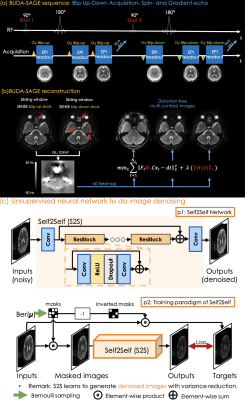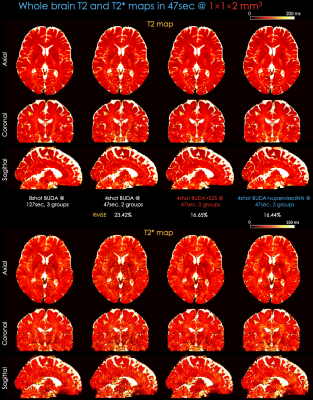Zijing Zhang1,2, Long Wang3, Hyeong-Geol Shin4, Jaejin Cho2, Tae Hyung Kim2, Jongho Lee4, Jinmin Xu1, Tao Zhang3, Huafeng Liu1, and Berkin Bilgic2
1State Key Laboratory of Modern Optical Instrumentation, College of Optical Science and Engineering, Zhejiang University, Hangzhou, China, 2Department of Radiology, A. A. Martinos Center for Biomedical Imaging, Massachusetts general hospital, Boston, MA, United States, 3Subtle Medical Inc, Menlo Park, CA, United States, 4Laboratory for Imaging Science and Technology (LIST), Department of Electrical and Computer Engineering, Seoul National University, Seoul, Korea, Republic of
1State Key Laboratory of Modern Optical Instrumentation, College of Optical Science and Engineering, Zhejiang University, Hangzhou, China, 2Department of Radiology, A. A. Martinos Center for Biomedical Imaging, Massachusetts general hospital, Boston, MA, United States, 3Subtle Medical Inc, Menlo Park, CA, United States, 4Laboratory for Imaging Science and Technology (LIST), Department of Electrical and Computer Engineering, Seoul National University, Seoul, Korea, Republic of
BUDA-SAGE with unsupervised denoising
enables fast, distortion-free, high-resolution T2, T2*, iron and myelin
susceptibility mapping

(a). BUDA-SAGE sequence diagram. Each scan can provide 3-echoes (one gradient echo, one mixed gradient-and spin echo, and one spin echo). Multiple scans can provide additional contrasts by changing the TEs of the sequence.(b). BUDA-SAGE reconstruction pipeline. (a) We conduct sliding window SENSE reconstruction for blip-up shots and blip-down shots, then put them into topup to estimate B0 field map. We incorporate B0 field map into MUSSELS to do BUDA reconstruction for all echoes. (c). The framework and training paradigm of the Self2Self model.

Whole-brain, distortion-free quantitative T2 and T2* maps at 1×1×2 mm3 resolution were obtained using Bloch dictionary matching using the multi-contrast images. We use 8-shot, 3-groups data (acquisition time: 140s=40s/group+5s dummy) as a reference. We provide the maps based on the reconstruction method of BUDA, BUDA+S2s, BUDA+supervisedNN with a subset of 2-groups, 4-shot data (acquisition time: 47s=20s/group + 5s dummy). BUDA+S2S with 2-groups, 4-shot data obtained comparable maps respect to those from 3-groups, 8-shot data.